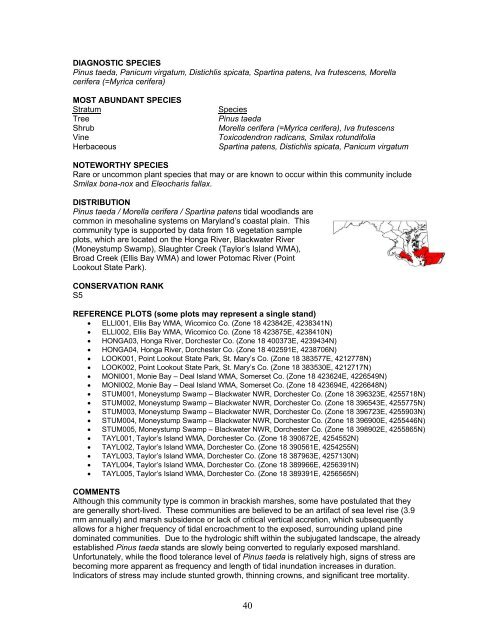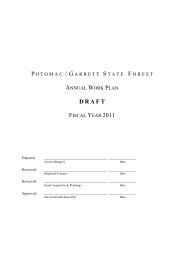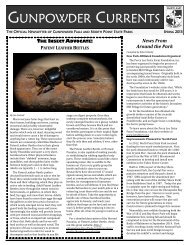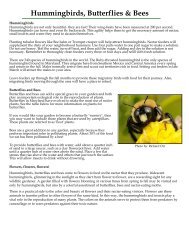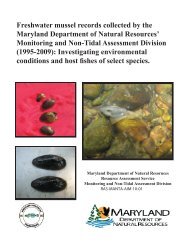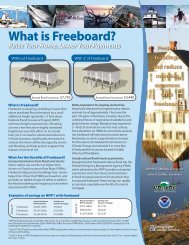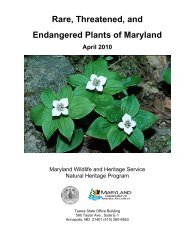tidal hardwood swamps - Maryland Department of Natural Resources
tidal hardwood swamps - Maryland Department of Natural Resources
tidal hardwood swamps - Maryland Department of Natural Resources
You also want an ePaper? Increase the reach of your titles
YUMPU automatically turns print PDFs into web optimized ePapers that Google loves.
DIAGNOSTIC SPECIES<br />
Pinus taeda, Panicum virgatum, Distichlis spicata, Spartina patens, Iva frutescens, Morella<br />
cerifera (=Myrica cerifera)<br />
MOST ABUNDANT SPECIES<br />
Stratum Species<br />
Tree Pinus taeda<br />
Shrub Morella cerifera (=Myrica cerifera), Iva frutescens<br />
Vine Toxicodendron radicans, Smilax rotundifolia<br />
Herbaceous Spartina patens, Distichlis spicata, Panicum virgatum<br />
NOTEWORTHY SPECIES<br />
Rare or uncommon plant species that may or are known to occur within this community include<br />
Smilax bona-nox and Eleocharis fallax.<br />
DISTRIBUTION<br />
Pinus taeda / Morella cerifera / Spartina patens <strong>tidal</strong> woodlands are<br />
common in mesohaline systems on <strong>Maryland</strong>’s coastal plain. This<br />
community type is supported by data from 18 vegetation sample<br />
plots, which are located on the Honga River, Blackwater River<br />
(Moneystump Swamp), Slaughter Creek (Taylor’s Island WMA),<br />
Broad Creek (Ellis Bay WMA) and lower Potomac River (Point<br />
Lookout State Park).<br />
CONSERVATION RANK<br />
S5<br />
REFERENCE PLOTS (some plots may represent a single stand)<br />
• ELLI001, Ellis Bay WMA, Wicomico Co. (Zone 18 423842E, 4238341N)<br />
• ELLI002, Ellis Bay WMA, Wicomico Co. (Zone 18 423875E, 4238410N)<br />
• HONGA03, Honga River, Dorchester Co. (Zone 18 400373E, 4239434N)<br />
• HONGA04, Honga River, Dorchester Co. (Zone 18 402591E, 4238706N)<br />
• LOOK001, Point Lookout State Park, St. Mary’s Co. (Zone 18 383577E, 4212778N)<br />
• LOOK002, Point Lookout State Park, St. Mary’s Co. (Zone 18 383530E, 4212717N)<br />
• MONI001, Monie Bay – Deal Island WMA, Somerset Co. (Zone 18 423624E, 4226549N)<br />
• MONI002, Monie Bay – Deal Island WMA, Somerset Co. (Zone 18 423694E, 4226648N)<br />
• STUM001, Moneystump Swamp – Blackwater NWR, Dorchester Co. (Zone 18 396323E, 4255718N)<br />
• STUM002, Moneystump Swamp – Blackwater NWR, Dorchester Co. (Zone 18 396543E, 4255775N)<br />
• STUM003, Moneystump Swamp – Blackwater NWR, Dorchester Co. (Zone 18 396723E, 4255903N)<br />
• STUM004, Moneystump Swamp – Blackwater NWR, Dorchester Co. (Zone 18 396900E, 4255446N)<br />
• STUM005, Moneystump Swamp – Blackwater NWR, Dorchester Co. (Zone 18 398902E, 4255865N)<br />
• TAYL001, Taylor’s Island WMA, Dorchester Co. (Zone 18 390672E, 4254552N)<br />
• TAYL002, Taylor’s Island WMA, Dorchester Co. (Zone 18 390561E, 4254255N)<br />
• TAYL003, Taylor’s Island WMA, Dorchester Co. (Zone 18 387963E, 4257130N)<br />
• TAYL004, Taylor’s Island WMA, Dorchester Co. (Zone 18 389966E, 4256391N)<br />
• TAYL005, Taylor’s Island WMA, Dorchester Co. (Zone 18 389391E, 4256565N)<br />
COMMENTS<br />
Although this community type is common in brackish marshes, some have postulated that they<br />
are generally short-lived. These communities are believed to be an artifact <strong>of</strong> sea level rise (3.9<br />
mm annually) and marsh subsidence or lack <strong>of</strong> critical vertical accretion, which subsequently<br />
allows for a higher frequency <strong>of</strong> <strong>tidal</strong> encroachment to the exposed, surrounding upland pine<br />
dominated communities. Due to the hydrologic shift within the subjugated landscape, the already<br />
established Pinus taeda stands are slowly being converted to regularly exposed marshland.<br />
Unfortunately, while the flood tolerance level <strong>of</strong> Pinus taeda is relatively high, signs <strong>of</strong> stress are<br />
becoming more apparent as frequency and length <strong>of</strong> <strong>tidal</strong> inundation increases in duration.<br />
Indicators <strong>of</strong> stress may include stunted growth, thinning crowns, and significant tree mortality.<br />
40


